

ENSO and other large scale things. Which produces more CO2, volcanic or human activity? A weekly feature provided by scientists at the Hawaiian Volcano Observatory.

People who are fortunate enough to live in or visit Hawai`i, or even those who have seen the right television documentaries know that the majestic presence of erupting volcanoes attests to their raw power. Don't try this trick at home, but if we took Kilauea (our own backyard volcano) and collected the lava that it erupted, just during the time it took you to read this sentence, there would be enough material to fill the gas tanks of about 1,000 Sport Utility Vehicles (SUVs.) Summary IPCC 4. What's causing global warming? Look for the fingerprints. Scientists are a skeptical bunch.
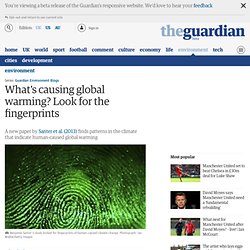
We never accept claims without evidence and we spend large parts of our careers trying to show that other scientist's claims are wrong. This self scrutiny is one of our best traits, and it is a major reason why science advances over time. With this said, it often surprises people that scientists are in such strong agreement about human impacts on the Earth's climate. Many studies, including research by Doran and Zimmerman, Anderegg and colleagues, and more recently by my colleague's team, Cook et al., have shown conclusively that the world's climate scientists agree, to about 97 percent, that humans are significantly impacting the climate.
Sea Levels Online - Mean Sea Level Trend. Mean Sea Level Trend8725520 Fort Myers, Florida The mean sea level trend is 2.40 millimeters/year with a 95% confidence interval of +/- 0.65 mm/yr based on monthly mean sea level data from 1965 to 2006 which is equivalent to a change of 0.79 feet in 100 years.

NEW! Updated Mean Sea Level Trends The plot shows the monthly mean sea level without the regular seasonal fluctuations due to coastal ocean temperatures, salinities, winds, atmospheric pressures, and ocean currents.
Effects. Global climate change has already had observable effects on the environment.
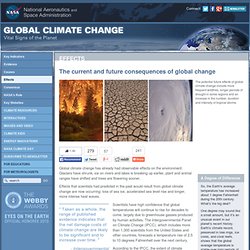
Glaciers have shrunk, ice on rivers and lakes is breaking up earlier, plant and animal ranges have shifted and trees are flowering sooner. Effects that scientists had predicted in the past would result from global climate change are now occurring: loss of sea ice, accelerated sea level rise and longer, more intense heat waves. " Taken as a whole, the range of published evidence indicates that the net damage costs of climate change are likely to be significant and to increase over time.
" - Intergovernmental Panel on Climate Change Scientists have high confidence that global temperatures will continue to rise for decades to come, largely due to greenhouse gasses produced by human activities. The Intergovernmental Panel on Climate Change (IPCC), which includes more than 1,300 scientists from the United States and other countries, forecasts a temperature rise of 2.5 to 10 degrees Fahrenheit over the next century.
Global warming’s new natural disaster: “Himalayan tsunamis” NEW DELHI, India — This summer’s devastating “Himalayan tsunami” is a grim omen for the future of the millions of people living downstream from the majestic mountain range.
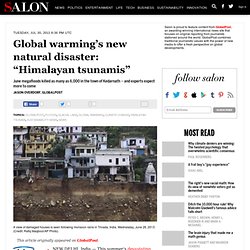
The June floods wiped out the Hindu pilgrimage town of Kedarnath and may have killed as many as 6,000 people. But the scale of the disaster could be dwarfed by future flooding, experts warn. “The Kedarnath floods may be only a small precursor to never-seen-before mega floods,” Maharaj K. How do human CO2 emissions compare to natural CO2 emissions? Before the industrial revolution, the CO2 content in the air remained quite steady for thousands of years.
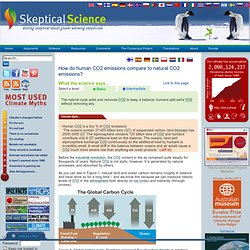
Natural CO2 is not static, however. Empirical evidence that humans are causing global warming. Posted on 9 July 2013 by gpwayne This post is a new 'basic' level rebuttal of the myth: "There is no actual empirical evidence that carbon dioxide emissions are causing global warming.

" What the Science Says: Less energy is escaping to space. Carbon dioxide (CO2) acts like a blanket; adding more CO2 makes the 'blanket' thicker It is the Earth’s atmosphere that makes most life possible. To understand this, we can look at the moon.
The Pause. Areosols. History of Climate Science. Extreme weather. Gigantic undersea mountains explain mystery near Antarctica. Cosmic Rays. Projections of Future Changes in Climate - AR4 WGI Summary for Policymakers. A major advance of this assessment of climate change projections compared with the TAR is the large number of simulations available from a broader range of models.
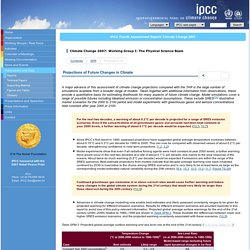
Taken together with additional information from observations, these provide a quantitative basis for estimating likelihoods for many aspects of future climate change. Model simulations cover a range of possible futures including idealised emission or concentration assumptions. These include SRES illustrative marker scenarios for the 2000 to 2100 period and model experiments with greenhouse gases and aerosol concentrations held constant after year 2000 or 2100. For the next two decades, a warming of about 0.2°C per decade is projected for a range of SRES emission scenarios. Even if the concentrations of all greenhouse gases and aerosols had been kept constant at year 2000 levels, a further warming of about 0.1°C per decade would be expected. {10.3, 10.7}